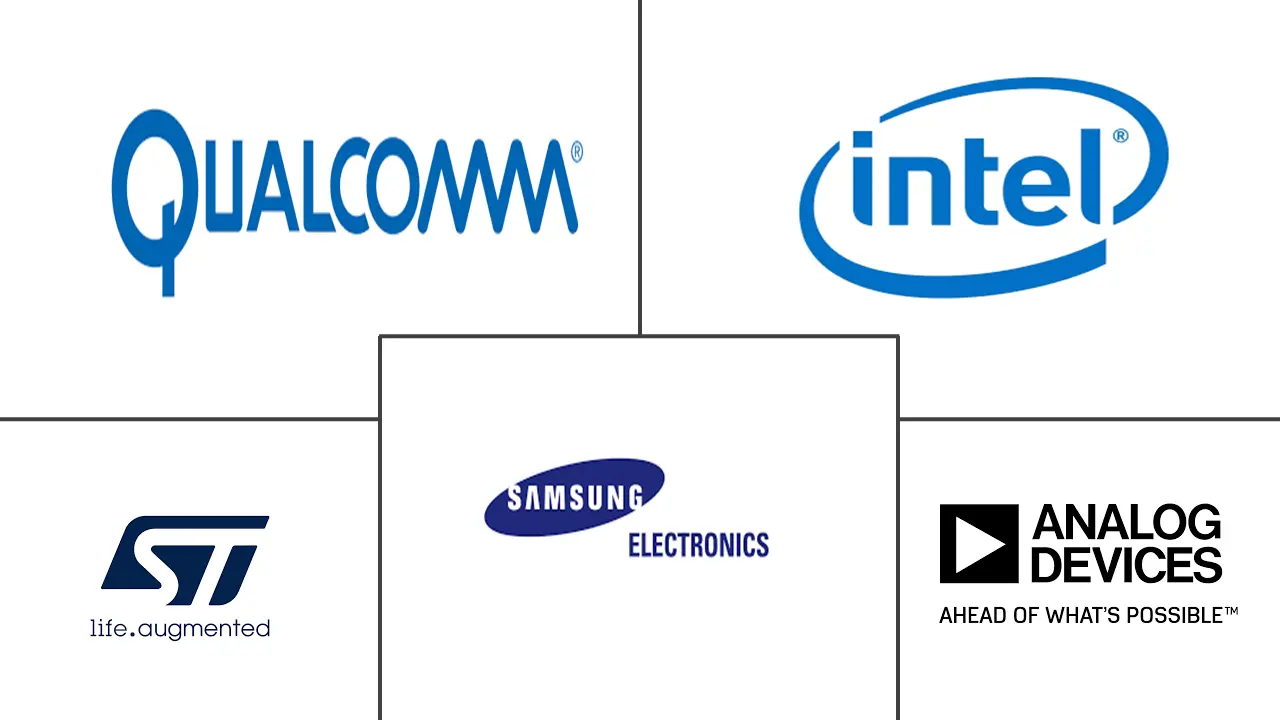IoT Chip Market Size and Share
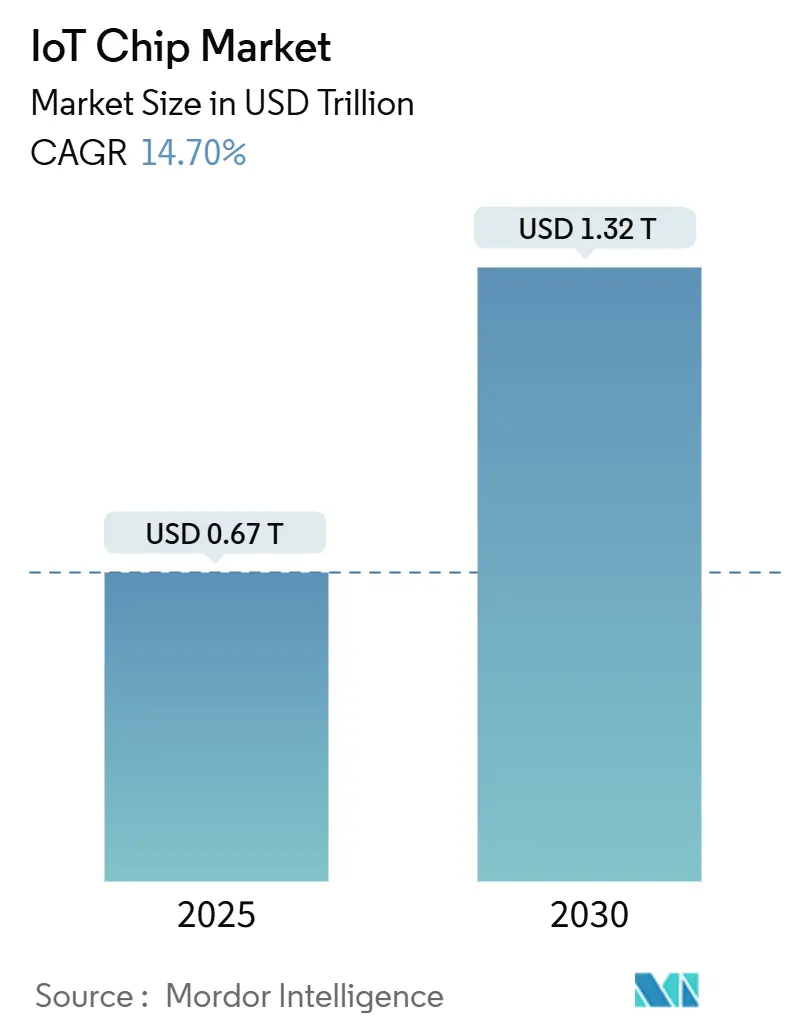
IoT Chip Market Analysis by Mordor Intelligence
The IoT Chip Market size is estimated at USD 0.67 trillion in 2025, and is expected to reach USD 1.32 trillion by 2030, at a CAGR of 14.70% during the forecast period (2025-2030). The Global IoT chip market size expansion is driven by distributed edge AI processing, industrial automation programs, and a steady increase in connected consumer devices. Manufacturers are shifting workloads from the cloud to the edge, compelling IoT silicon to incorporate neural acceleration while maintaining power budgets below single-digit milliwatts. Government incentives aimed at regionalizing semiconductor fabrication are encouraging new fabs in North America and Europe, while reshoring policies are altering sourcing strategies across the Global IoT Chip market. Supply-chain diversification aligns with technology-node bifurcation: advanced nodes (<14 nm) enable resource-intensive AI inference, while mature nodes (28–40 nm) maintain competitive costs for mass-market sensors.[1]U.S. Department of Commerce, “Semiconductor Industry,” commerce.gov
Key Report Takeaways
- By product, processors held 25.65% of the IoT Chip market share in 2024; security ICs are projected to expand at a 17.90% CAGR through 2030.
- By end-user, the industrial and manufacturing sector commanded a 22.71% share of the IoT Chip market in 2024, while the automotive sector is poised to grow at a 16.74% CAGR to 2030.
- By technology node, the 40-28 nm segment led with a 27.66% share of the IoT Chip market in 2024; the ≤14 nm segment is forecast to advance at a 19.01% CAGR.
- By connectivity technology, Wi-Fi captured a 38.60% revenue share of the IoT Chip market in 2024; 5G RedCap is the fastest-growing segment at a 19.22% CAGR.
- By geography, Asia-Pacific accounted for 34.92% of the IoT Chip market size in 2024; the Middle East and Africa region is forecast to rise at a 18.71% CAGR.
Global IoT Chip Market Trends and Insights
Drivers Impact Analysis
| Driver | (~) % Impact on CAGR Forecast | Geographic Relevance | Impact Timeline |
|---|---|---|---|
| Proliferation of connected consumer and wearable devices | +3.20% | Global, with concentration in North America and Asia Pacific | Medium term (2-4 years) |
| Industry 4.0-led demand for low-power MCUs | +2.80% | Asia Pacific core, spill-over to Europe and North America | Long term (≥ 4 years) |
| Automotive ADAS and V2X silicon requirements | +2.40% | Global, early adoption in Europe and North America | Medium term (2-4 years) |
| Edge-AI inference inside IoT SoCs | +2.10% | Global, led by North America and Asia Pacific | Short term (≤ 2 years) |
| Matter protocol accelerating smart-home refresh cycles | +1.80% | North America and Europe, expanding to Asia Pacific | Short term (≤ 2 years) |
| Satellite and sub-GHz connectivity for remote asset tracking | +1.50% | Global, with emphasis on rural and remote regions | Long term (≥ 4 years) |
| Source: Mordor Intelligence | |||
Proliferation of Connected Consumer and Wearable Devices
Demand for ambient computing experiences is lifting volumes for ultra-low-power chips that keep sensors and radios active at all times. Health-focused wearables now integrate medical-grade photoplethysmography, temperature, and ECG sensors that need secure data paths to comply with tightening privacy rules. Qualcomm reported USD 1.5 billion in IoT revenue for Q1 2025, up 36% year over year, underscoring consumer momentum. As 5G modems converge with on-device AI, designers shift to heterogeneous SoCs that fuse application processors, NPUs, and connectivity on one die, driving silicon-area efficiency across the Global IoT Chip market.
Industry 4.0-Led Demand for Low-Power MCUs
Factories deploying digital twins and predictive maintenance lean on microcontrollers that ingest vibration, thermal, and acoustic data locally, cutting network latency. Intel’s smart-factory line achieved near-theoretical yield through real-time lithography calibration, proving the value of edge analytics inside harsh environments. Rugged MCUs now combine machine-learning instruction sets with secure boot and OTA updates, positioning the Global IoT Chip market for sustained industrial orders through the decade.[2]NXP Semiconductors, “NXP Agrees to Acquire Edge AI Pioneer Kinara to Redefine the Intelligent Edge,” nxp.com
Automotive ADAS and V2X Silicon Requirements
Sensor-fusion workloads for L2+ autonomy require chips that process multiple 4 k video streams while meeting ASIL-D functional-safety targets. Qualcomm’s automotive revenue rose 59% year over year to USD 959 million in Q2 2025, reflecting automaker adoption of centralized compute platforms. Dedicated V2X modems that aggregate 5G, Wi-Fi 6E, and sidelink channels are moving into mass production, expanding the Global IoT Chip market beyond infotainment domains.
Edge-AI Inference Inside IoT SoCs
On-device learning reduces cloud roundtrips and safeguards data. NXP’s USD 307 million acquisition of Kinara brings energy-efficient NPUs that deliver 0.5 TOPS per milliwatt for predictive-maintenance models. Advanced packaging such as fan-out RDL stacks high-bandwidth memory next to compute blocks, enabling small footprints for wearables and industrial sensors within the Global IoT Chip market.
Restraints Impact Analysis
| Restraint | (~) % Impact on CAGR Forecast | Geographic Relevance | Impact Timeline |
|---|---|---|---|
| End-to-end security and privacy vulnerabilities | -2.10% | Global, with heightened concerns in Europe and North America | Short term (≤ 2 years) |
| Fragmented communications standards | -1.80% | Global, particularly affecting interoperability initiatives | Medium term (2-4 years) |
| Legacy-node (28/40 nm) foundry capacity crunch | -1.50% | Global, concentrated in Asia Pacific manufacturing hubs | Short term (≤ 2 years) |
| Export-control limits on advanced RF IP | -1.20% | China and restricted regions, indirect global impact | Long term (≥ 4 years) |
| Source: Mordor Intelligence | |||
End-to-End Security and Privacy Vulnerabilities
The White House Cyber Trust Mark requires compliance with NIST IR 8425, raising the bar for secure-element integration in resource-limited devices. Cost-sensitive OEMs face additional silicon area and firmware validation expenses. Rising quantum-computing threats press chipmakers to support lattice-based cryptography, delaying product launches and tempering short-term Global IoT Chip market growth.[3]OpenSystems Media, “U.S. Cyber Trust Mark: Security Guidance for IoT Product Designers,” embeddedcomputing.com
Legacy-Node (28/40 nm) Foundry Capacity Crunch
Foundries prioritize high-margin 5 nm and 3 nm lines, limiting mature-node wafers essential for ultra-low-cost sensors. Supply tightness elevates die-cost curves and sparks design migrations to smaller geometries sooner than roadmaps anticipated, pressuring profit margins across the Global IoT Chip market.
Segment Analysis
By Product: Processors Lead, Security ICs Accelerate
Processors generated the largest revenue slice in 2024 at 25.65%, anchored by single-die combos that merge CPU, NPU, and multi-protocol radios. Enhanced integration trims printed-circuit area and shortens certification cycles, fortifying processor dominance in the Global IoT Chip market. Security ICs are poised for the fastest expansion with a 17.90% CAGR as zero-trust architectures embed hardware roots-of-trust into every node of the IoT Chip market. Sensor, connectivity, memory, logic, and power-management lines track broader unit shipment curves, with specialized low-power DRAM commanding premium price points.
Upgrades in in-package voltage regulation now supply sub-0.5 V rails for AI accelerators, extending battery life in wearables. MEMS makers push shippable pressure sensors below 0.8 mm height, opening design space in rings and earbuds. SEALSQ secured contracts for 24 million quantum-resistant chips that protect UK smart meters, showcasing a security shift across critical infrastructure.
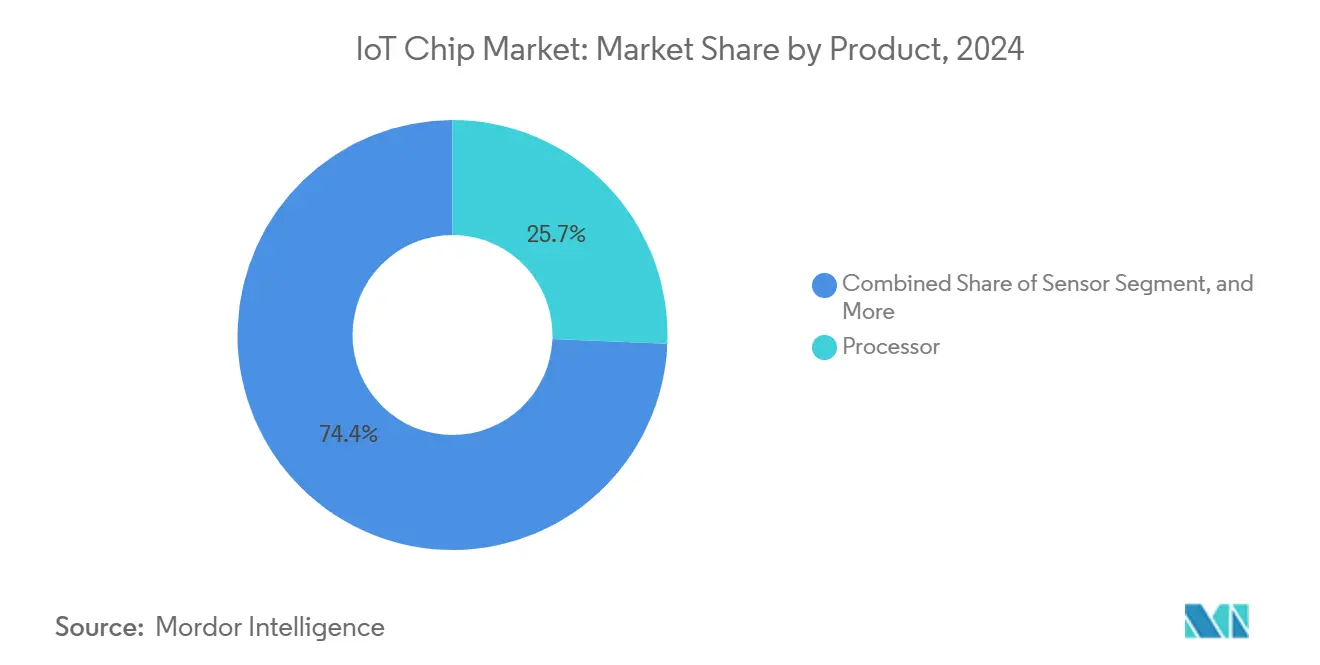
Note: Segment shares of all individual segments available upon report purchase
By End-User: Industrial Commands Volume, Automotive Scales Fast
Industrial and manufacturing retained a 22.71% share in 2024 as digital-twin rollouts scaled across Asia Pacific plants. Demand for condition-monitoring MCUs sustains double-digit unit growth through 2030. Automotive leads in CAGR at 16.74% as software-defined vehicles centralize compute domains. The IoT Chip market size for automotive silicon is projected to climb sharply on the back of zonal architectures that cut harness weight and enable OTA feature upsells.
Healthcare extends beyond remote monitoring to regulated device connectivity frameworks, strengthening demand for certified secure elements. Retail pilots using AI-powered inventory robots enlist vision-optimized SoCs to reconcile shelf stock in real time, diversifying the IoT Chip market revenue base. Building-automation orders rise as passive optical networks connect HVAC, lighting, and security over a single fibre backbone.
By Technology Node: Mature Nodes Dominate, Advanced Nodes Surge
The 40–28 nm tier held 27.66% share in 2024, underpinning cost-sensitive wearables and sensors in the IoT Chip market. Design reuse and fully depreciated tooling keep die costs low, though capacity constraints tighten supply. The ≤14 nm tier grows at 19.01% CAGR as edge-AI workloads need dense SRAM and LPDDR interfaces. TSMC’s nanosheet-based 2 nm path promises 15% speed gains with 30% lower power, pointing to further AI-centric growth.
In parallel, 22–16 nm FinFET nodes balance performance and cost for mid-range gateways. Legacy ≥90 nm lines remain viable for ultra-low-end sensors, although volumes slide as integration benefits. Favor mixed-signal SoCs at smaller geometries within the IoT Chip market.
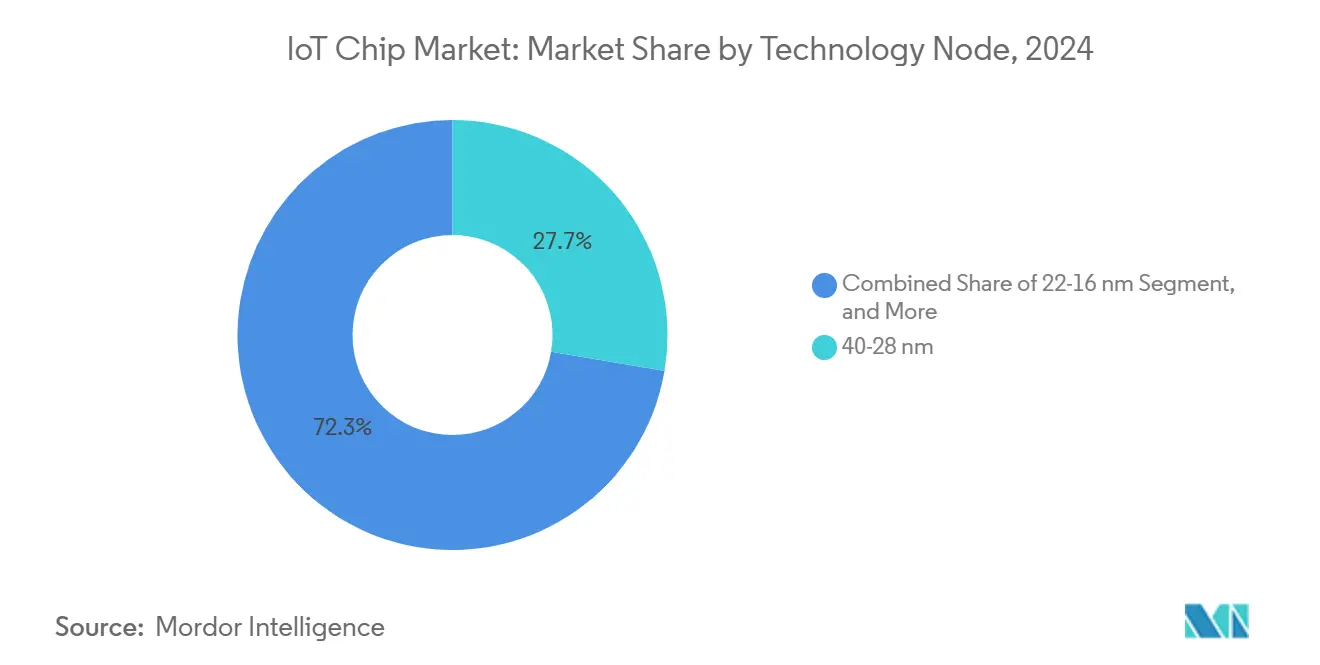
Note: Segment shares of all individual segments available upon report purchase
By Connectivity Technology: Wi-Fi Rules, 5G RedCap Emerges
Wi-Fi held 38.60% revenue in 2024, buoyed by Wi-Fi 6E rollouts that triple available spectrum. Thread and Zigbee gain renewed attention under the Matter umbrella, simplifying commissioning flows. 5G RedCap chips scale at 19.22% CAGR, bridging the gap between NB-IoT and full 5G, with AT&T executing the first U.S. carrier launch in 2024. Satellite IoT startups launch low-earth constellations, extending coverage to maritime and mining assets, expanding total addressable endpoints for the IoT Chip market.
Ultra-wideband anchors precision ranging in automotive keyless entry and asset-tracking tags. NB-IoT and LTE-M hold steady in utilities, where 10-year battery life outweighs bandwidth needs. Combined protocol SoCs mitigate PCB area growth, reinforcing multi-radio coexistence as a design norm.
Geography Analysis
Asia-Pacific contributed 34.92% of the IoT Chip market revenue in 2024, propelled by Taiwan’s 63.8% share of total semiconductor output and China’s capacity build-out. Vertical integration from wafer to packaging lowers lead times, letting OEMs iterate faster. Yet export controls nudge multinational OEMs toward capacity hedging in Japan, India, and the United States, reshaping the IoT Chip market supply map.
The Middle East and Africa exhibit the fastest trajectory at 18.71% CAGR. Gulf smart-city budgets allocate billions for traffic analytics, energy dashboards, and public-safety sensor grids, demanding robust, wide-temperature-range silicon. 5G rollouts across North Africa unlock low-latency telemetry for logistics corridors stretching from ports to inland free-trade zones, enlarging the endpoint base for the IoT Chip market.
North America and Europe remain innovation centers. The U.S. CHIPS Act channels USD 50 billion into fabs across 16 states, doubling domestic advanced-node capacity to 22% by 2027. Europe’s Chips Act targets a 20% global share by 2030, with Intel and STMicroelectronics investing in Germany and France clusters. These regions prioritize high-value automotive and medical silicon, forming lucrative slices of the IoT Chip market size despite moderate unit growth.[4]Source: Taipei Representative Office in Singapore, “Taiwan and the Global Semiconductor Supply Chain,” roc-taiwan.org
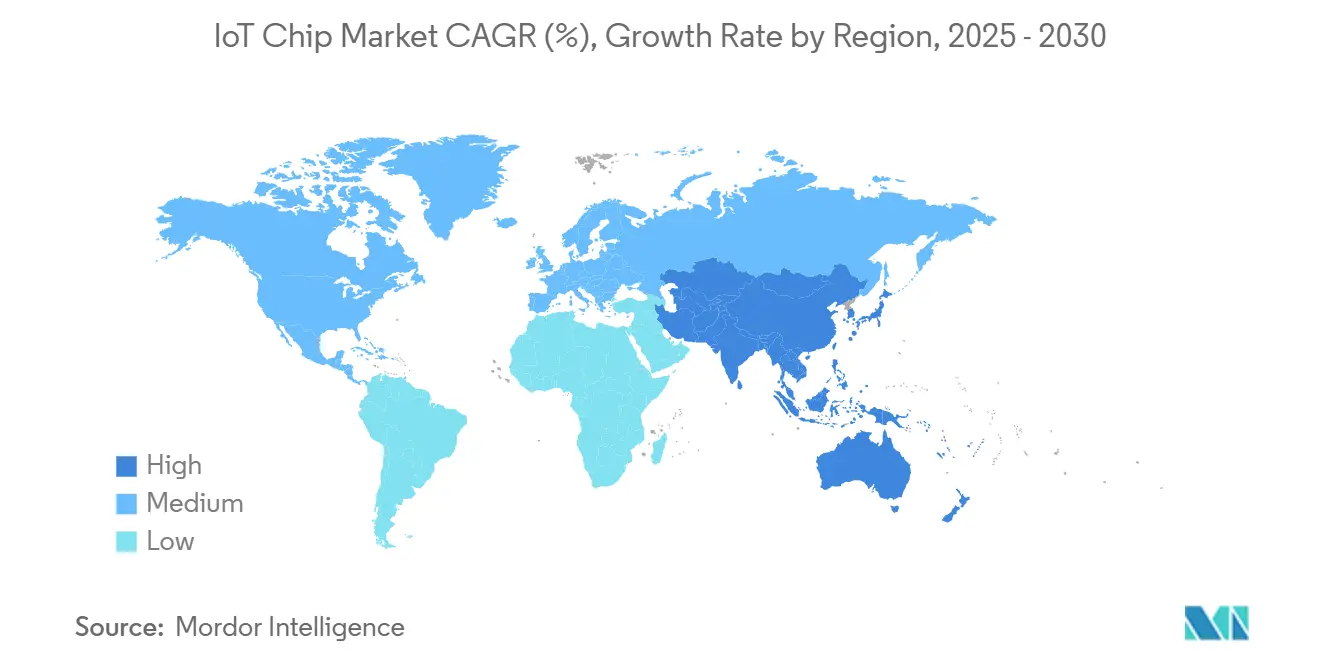
Competitive Landscape
The IoT Chip market shows moderate fragmentation. Top vendors exploit scale advantages in lithography R&D and multi-year wafer agreements, sustaining price leverage. Yet specialist start-ups differentiate with post-quantum security cores, sub-100 µW NPUs, and satellite-ready RF front ends. Partnerships multiply: Qualcomm joined STMicroelectronics to couple AI radios with STM32 MCUs shipping in 2025, providing turnkey boards for OEMs. Vertical integration trends push giants to secure silicon, software, and services under one brand, raising entry barriers.
Mid-tier suppliers collaborate with cloud hyperscalers for edge-SDK support. White-label ODMs in China and Taiwan iterate on reference designs to serve long-tail device makers, keeping downstream pricing competitive. As mature-node capacity tightens, buyers dual-source die revisions across foundries to hedge risk, amplifying vendor-management complexity throughout the Global IoT Chip market.
Third-party IP licensors open secure-element cores on flexible royalty terms, enabling Tier-2 MCU vendors to integrate cryptography quickly. This dynamic sustains a pipeline of feature-rich yet cost-aware alternatives, preventing rapid consolidation and keeping the Global IoT Chip market structurally competitive.
IoT Chip Industry Leaders
-
Qualcomm Technologies Inc.
-
Texas Instruments Incorporated
-
NXP Semiconductors N.V.
-
STMicroelectronics N.V.
-
MediaTek Inc.
- *Disclaimer: Major Players sorted in no particular order
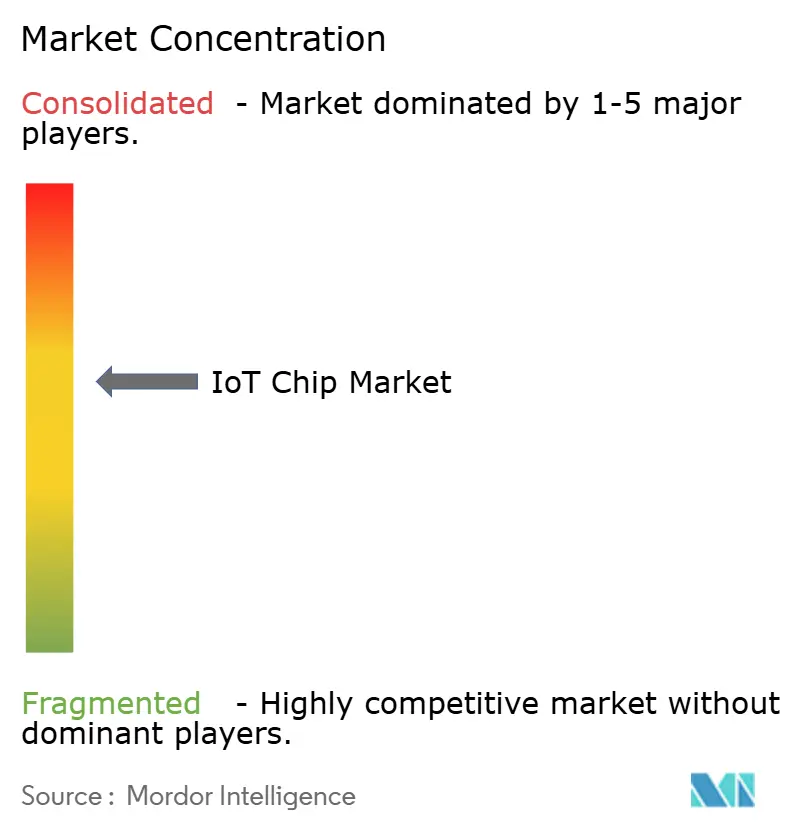
Recent Industry Developments
- May 2025: Semtech launched LoRa Plus LR2021 transceiver, the first chip that spans terrestrial and satellite LoRa networks.
- February 2025: NXP closed its USD 307 million Kinara acquisition, adding energy-efficient NPUs to its edge-AI line-up.
- January 2025: Infineon broke ground on a backend fab in Samut Prakan, Thailand, slated for 2026 volume ramp-up.
- January 2025: Microchip earmarked USD 880 million for silicon-carbide capacity expansion in Colorado Springs, creating 400 jobs.
Global IoT Chip Market Report Scope
The IoT Chip Market is Segmented by Product (Processor, Sensor, Connectivity IC, Memory Device, Logic Device, Power-Management IC, and Security IC), End-User (Healthcare, Consumer Electronics, Industrial and Manufacturing, Automotive, BFSI, Retail, Building Automation, and Other End-Users), Technology Node ( ≥90 nm, 65-45 nm, 40-28 nm, 22-16 nm, and ≤14 nm), Connectivity Technology (Bluetooth/BLE, Wi-Fi (802.11x), NB-IoT / LTE-M, 5G RedCap, Ultra-Wideband (UWB), Thread / Zigbee, and Satellite IoT), Processor Architecture (Arm-Based, RISC-V, x86, and Other / Hybrid), and Geography (North America, Europe, Asia Pacific, South America, and Middle East and Africa). The Market Forecasts are Provided in Terms of Value (USD).
| Processor |
| Sensor |
| Connectivity IC |
| Memory Device |
| Logic Device |
| Power-Management IC |
| Security IC |
| Healthcare |
| Consumer Electronics |
| Industrial and Manufacturing |
| Automotive |
| BFSI |
| Retail |
| Building Automation |
| Other End-users |
| ≥90 nm |
| 65-45 nm |
| 40-28 nm |
| 22-16 nm |
| ≤14 nm |
| Bluetooth / BLE |
| Wi-Fi (802.11x) |
| NB-IoT / LTE-M |
| 5G RedCap |
| Ultra-Wideband (UWB) |
| Thread / Zigbee |
| Satellite IoT |
| Arm-based |
| RISC-V |
| x86 |
| Other / Hybrid |
| North America | United States | |
| Canada | ||
| Mexico | ||
| South America | Brazil | |
| Argentina | ||
| Rest of South America | ||
| Europe | Germany | |
| United Kingdom | ||
| France | ||
| Italy | ||
| Spain | ||
| Rest of Europe | ||
| Asia-Pacific | China | |
| Japan | ||
| South Korea | ||
| India | ||
| Singapore | ||
| Australia | ||
| Rest of Asia-Pacific | ||
| Middle East and Africa | Middle East | Saudi Arabia |
| United Arab Emirates | ||
| Turkey | ||
| Rest of Middle East | ||
| Africa | South Africa | |
| Nigeria | ||
| Egypt | ||
| Rest of Africa | ||
| By Product | Processor | ||
| Sensor | |||
| Connectivity IC | |||
| Memory Device | |||
| Logic Device | |||
| Power-Management IC | |||
| Security IC | |||
| By End-user | Healthcare | ||
| Consumer Electronics | |||
| Industrial and Manufacturing | |||
| Automotive | |||
| BFSI | |||
| Retail | |||
| Building Automation | |||
| Other End-users | |||
| By Technology Node | ≥90 nm | ||
| 65-45 nm | |||
| 40-28 nm | |||
| 22-16 nm | |||
| ≤14 nm | |||
| By Connectivity Technology | Bluetooth / BLE | ||
| Wi-Fi (802.11x) | |||
| NB-IoT / LTE-M | |||
| 5G RedCap | |||
| Ultra-Wideband (UWB) | |||
| Thread / Zigbee | |||
| Satellite IoT | |||
| By Processor Architecture | Arm-based | ||
| RISC-V | |||
| x86 | |||
| Other / Hybrid | |||
| By Geography | North America | United States | |
| Canada | |||
| Mexico | |||
| South America | Brazil | ||
| Argentina | |||
| Rest of South America | |||
| Europe | Germany | ||
| United Kingdom | |||
| France | |||
| Italy | |||
| Spain | |||
| Rest of Europe | |||
| Asia-Pacific | China | ||
| Japan | |||
| South Korea | |||
| India | |||
| Singapore | |||
| Australia | |||
| Rest of Asia-Pacific | |||
| Middle East and Africa | Middle East | Saudi Arabia | |
| United Arab Emirates | |||
| Turkey | |||
| Rest of Middle East | |||
| Africa | South Africa | ||
| Nigeria | |||
| Egypt | |||
| Rest of Africa | |||
Key Questions Answered in the Report
What is the current value of the IoT Chip market?
The market is valued at USD 0.67 trillion in 2025 and is projected to reach USD 1.32 trillion by 2030.
Which product category leads the IoT Chip market?
Processors lead with 25.65% revenue share in 2024, supported by high integration of compute and connectivity.
Which end-user industry is growing fastest?
Automotive applications show the highest CAGR at 16.74% through 2030 due to ADAS and V2X adoption.
Which region has the largest IoT Chip market share?
Asia-Pacific holds 34.92% of revenue in 2024, benefiting from concentrated manufacturing capacity.
Why is 5G RedCap important for IoT?
5G RedCap offers a cost-efficient step-up from NB-IoT while supporting higher bandwidth, driving a 19.22% CAGR in connectivity chips.
How are security concerns influencing chip design?
Compliance with initiatives like the U.S. Cyber Trust Mark is pushing secure element attach rates higher, adding dedicated cryptographic hardware into mainstream IoT SoCs.
Page last updated on:
